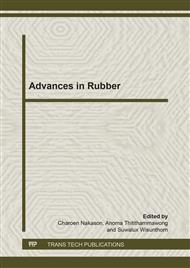p.410
p.417
p.421
p.425
p.429
p.433
p.437
p.441
p.445
Electrical Properties Characterization and Numerical Models of Rubber Composite at High Frequency
Abstract:
This paper presents a numerical model of rubber composite using a COMSOL multiphysics program to simulate electrical properties of the rubber composite in the frequency range of 300 kHz to 30 MHz. The rubber composite was made of natural rubber vulcanized with carbon black and carbon nanotube. The chracterization was done by setting up a parallel plate capacitive structure in a shape of circular disk with a diameter of 38 mm and using the RF vector network analyzer to measure electrical properties in term of electrical impedance, specifically resistance (R) and reactance (X). Three different thinknesses of rubber composite sheets were used in the experiment, specifically 0.7 mm, 1.7 mm, and 2.9 mm. From the physical dimension of the test setup, capacitance (C), dissipation factor (D), relative permitivity (εr), and conductivity (σ) can be calculated. These extracted parameters together with the physical dimension of the test structure were used to create COMSOL multiphysics simulation models. The program can simulate non-linear modeling of the rubber composite under different electromagnetic constrains. The simulation results were compared to the measured results for all samples. Comparison results show that all electrical parameters were closly matched, indicating that the COMSOL multiphysics models were correctly generated. The results also indicate that the conductivity and the relative permittivity of the tested rubber composite change dramatically at the frequency above 10 MHz. The results indicate the physical limit of the tested rubber composite in the sensing application. The simulation model proposed in this paper can be used to design and possibly predict the geometical and electrical properties of the rubber composite in future applications.
Info:
Periodical:
Pages:
429-432
Citation:
Online since:
November 2013
Price:
Сopyright:
© 2014 Trans Tech Publications Ltd. All Rights Reserved
Share:
Citation:


